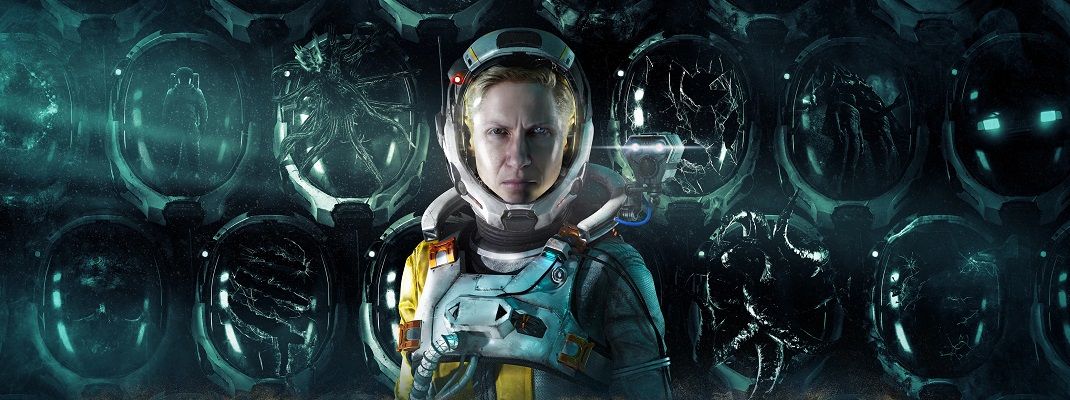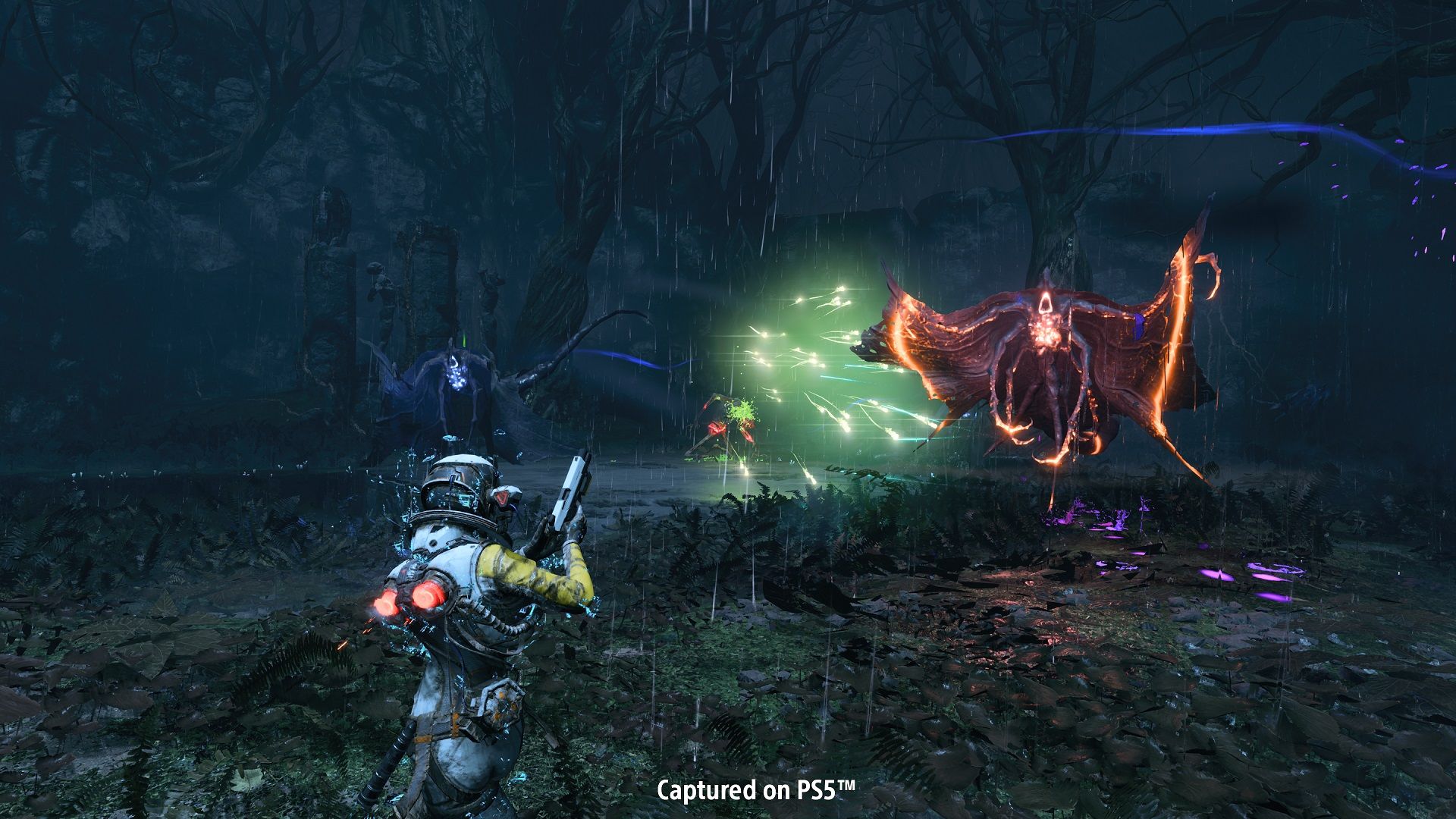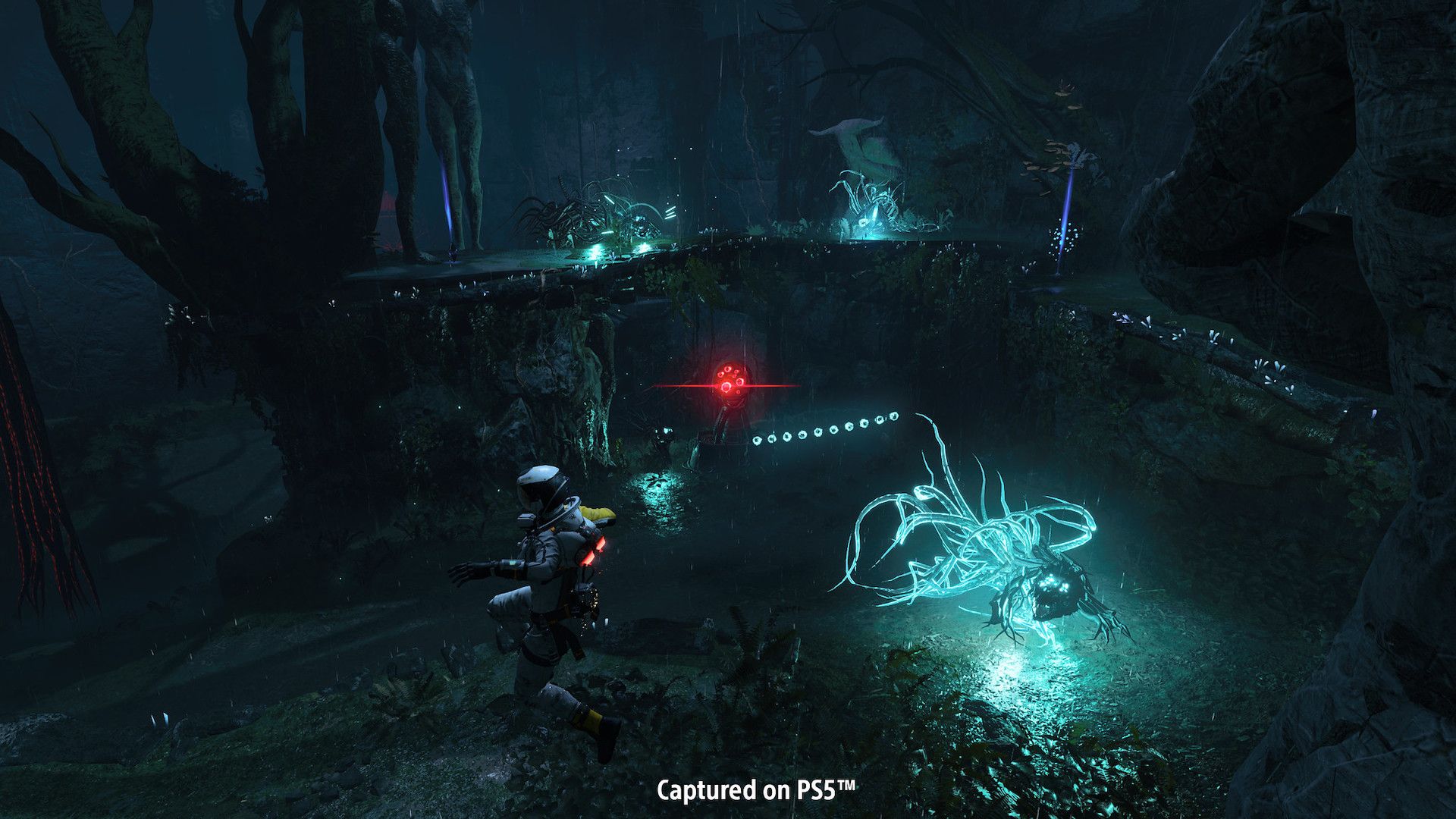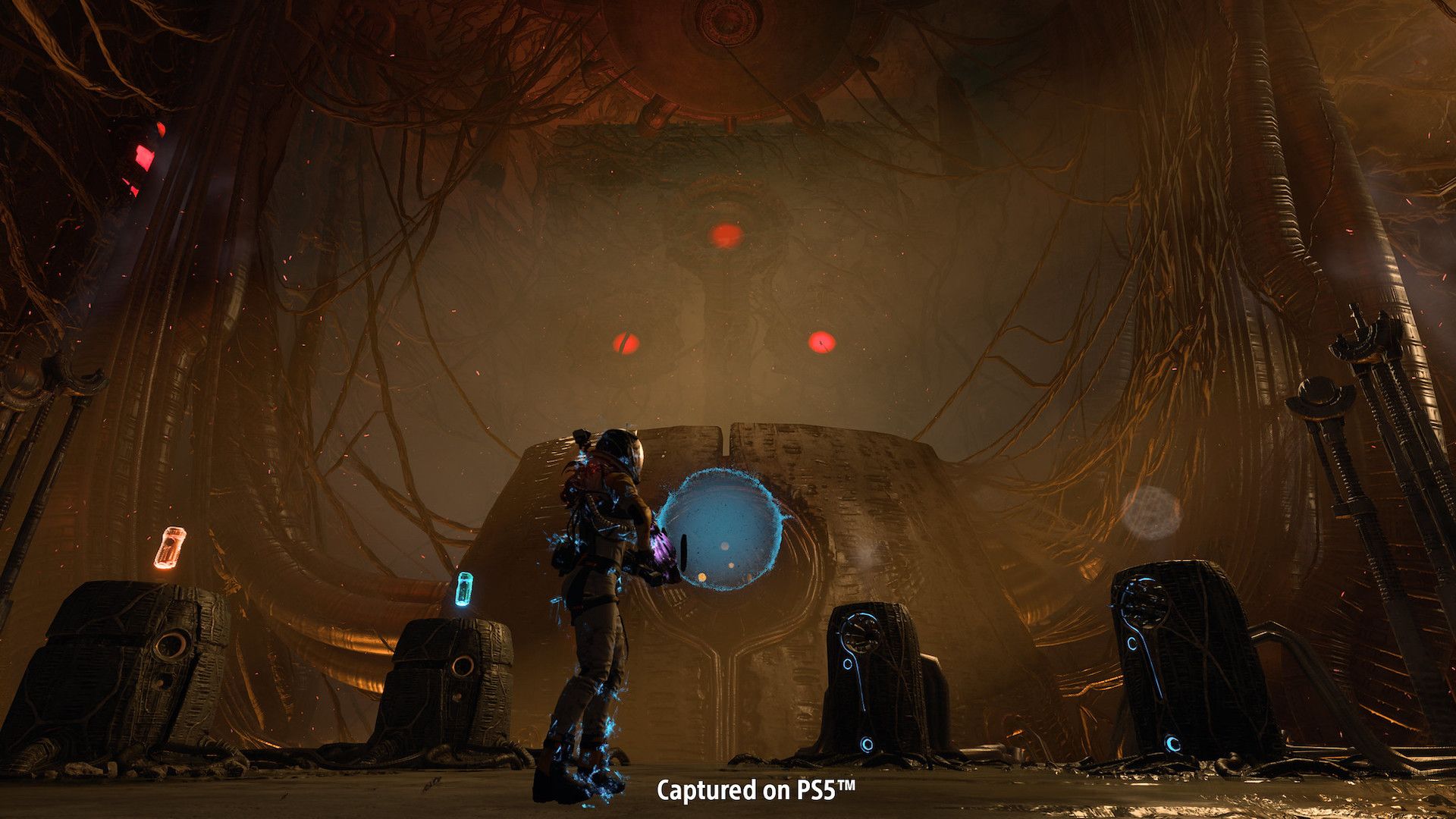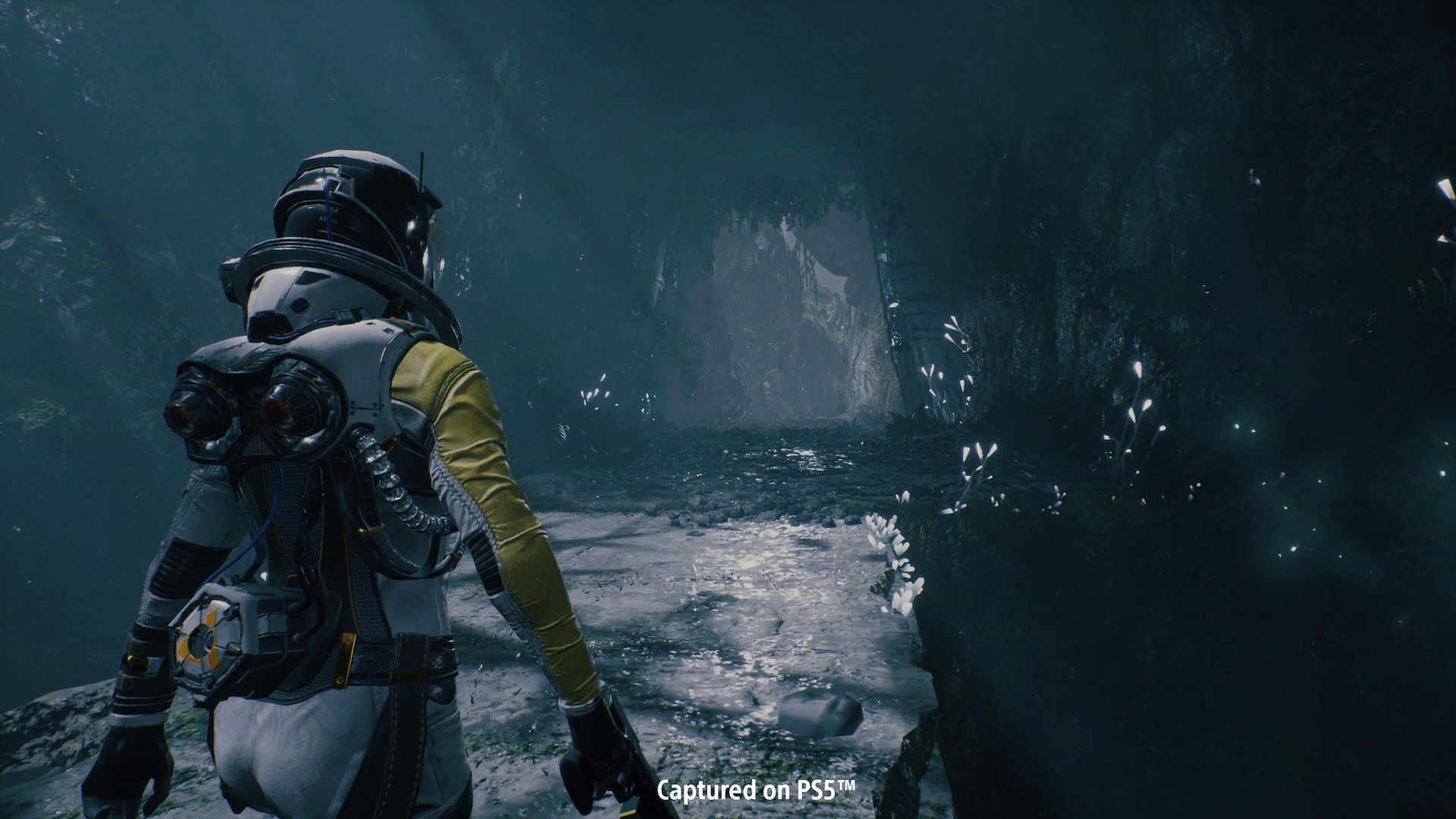Housemarque made a name for itself developing high-quality arcade titles like Super Stardust HD, Resogun and Dead Nation. After more than a decade mastering the genre, Housemarque is taking a bold new step with its latest title, Returnal, and a bold step it is. Returnal is a whole new beast for the developer, dropping them into a new world filled with ambitious gameplay, design and storytelling unlike anything they’ve attempted before. Is Returnal another successful entry in Housemarque’s portfolio or is it, like the protagonist, doomed to live, die and repeat endlessly?
Returnal follows Selene, a Greek-American Astra deep-space scout drawn to the planet of Atropos after discovering a mysterious broadcast signal. Her ship crash lands, however, forcing her to scavenge the planet and discover a horrible truth after finding her corpse; she’s in a time-loop, doomed to resurrect no matter how many times she dies. With only the mysterious broadcast left to keep her going, Selene embarks on a perilous quest where she’ll encounter not only the horrors of Atropos, but also the horrors of her past.
Despite trailers showcasing a heavy focus on narrative, Returnal takes a slow-burn approach with its storytelling. The game weaves narrative elements into its world and presents them to players through audio journals left behind by dead versions of Selene, cryptoglyphs and Xeno-artifacts. The most overt forms of storytelling come from House Sequences, which forces the game into a first-person perspective as Selene experiences trippy life sequences on Earth.
Returnal’s story takes an entire playtime to uncover. Initially vague, every audio log and House Sequence help add new layers of intrigue into the psyche of Selene. Returnal tells an interesting story that will keep players guessing across its many hours of playtime. Even if the ending doesn’t land as firmly as the other story beats, this is still a tale well worth uncovering as you explore Atropos. The plot is split across three acts and can easily take 15-20 hours to complete. Theoretically, Returnal is beatable quicker than that with minimal deaths and maintaining strict adherence to the main path, but it’s still easy to get sucked into the world of Atropos and its many biomes.
Playtime is split across six mostly unique biomes, complete with their own lists of enemies, traps and perils. Returnal has a little bit of everything across its settings, from rainy ruins to sun-bleached sands to frozen wastes. The biomes do more than serve as pretty window-dressing, though. Each biome’s layouts force players and Selene to switch up their strategies. Biomes 1 and 4 heavily focus on verticality, but Biomes 2 and 5 are flatter, forcing players to focus more on dodging and jumping than using different levels to get the leg up on enemies.
Five of the six biomes are generally excellent, positively ramping up the difficulty while encouraging players to master and learn the mechanics. The notable exception is Biome 5, which feels awkwardly out of place with the rest of Returnal. Rather than exploring the environment, Biome 5 is essentially a gauntlet of challenges in an attempt to recover keys. It’s by far the most gamified section of Returnal and ratchets up the difficulty greater than most players might expect. It nearly makes the rest of the game feel more manageable in comparison.
Most integral to the design is the death loop. Returnal blends roguelike elements into its design to create a punishing yet rewarding experience. Every death restarts Selene back at Helios with all non-permanent items lost. Upon rebirth, sections of the world are remixed, enemy placements altered, and new items laid throughout the world. Returnal uses its loop to teach and challenge players to get better, and for the most part, it successfully delivers a high level of challenge that effectively does train players. Working against Returnal is the fact that the game can get repetitive. For as procedural the game gets with each death, each biome only has so many different layouts it can piece together. This becomes a particular problem in the second half where two of those three biomes feature some reskinned layouts from Biomes 1 and 2. The second half of the game also turns death into more of a punishment than a learning experience. While the first half of the game generally makes it simple to get back to Biomes 2 and 3, the second half makes it a painful slog to get back on course. Thankfully, the gameplay in between is fantastic.
Returnal isn’t an arcade game, but it still blends elements of Housemarque’s previous titles with new mechanics and technologies to deliver a fast-paced, highly-enjoyable shooter. Returnal naturally merges key aspects of a third-person shooter with the bullet hell, shoot-em-up action the studio built its reputation with. Like a third-person shooter, you’ll roam a 3D world, directly control Selene and occasionally aim over the shoulder. On the flipside, like bullet hell shooters, you’ll be observing enemies, learning their attack patterns and dashing about in an attempt to get the upper hand.
To say that Returnal is a fast and frenetic shooter that requires your full attention is an understatement. To master Returnal means to keep moving, dodging at the appropriate time, and understanding the different types of attacks thrown at you. Returnal is very much a dance, a challenging one with various colored attacks lobbed your way, but a dance nonetheless. Helping you get out alive is a variety of fun and unique weapons that include standard pistols, carbines, LMGs and shotguns, as well as more exotic and inventive weapons like an acid launcher and electricity darts. The more you use a weapon, the better it gets, adding new passive benefits like corrosive damage for the LMG. All the weapons are a blast to shoot in no small part to the excellent DualSense support.
Returnal fully embraces the PS5’s unique features to enhance its gameplay, with the DualSense integration standing as the best use of the haptics and adaptive triggers to date. You’ll feel your ship, Helios, crashing, every hit and raindrop land on Selene. The adaptive triggers are used nicely with L2. A light press activates ADS, but fully pressing down activates the weapon’s alt-fire mode. It’s a unique sensation that does take some time to get used to but ends up working well after practice. It’s an impressive display of the technology that adds surprising depth to the gameplay.
As a PS5 exclusive, expectations for Returnal’s presentation are expectedly high. Luckily, Housemarque has delivered a haunting title dripping with atmosphere, pleasantly-detailed environments and tons of particle effects that fill the screen. Returnal delivers that next-gen sheen with a 4K resolution with a near-perfect 60fps and some ray traced lighting. Atropos is a dark and depressing world, a fact the game beautifully renders, but it can get too dark. This is a game where you might need to increase the brightness, particularly in Biome 6. Despite this, Returnal looks good on the eyes, but just as is impressive is the audio.
Returnal’s audio design is top-notch. The world is alive, filled with alien noises, bursting vegetation, vines trying to entangle you and so much more. The audio does a lot to pull you into the world, especially if you choose to play with a 3D audio headset. As cliché as it may sound, 3D audio is brilliantly used to pull people into the world. Hearing the rain bounce off Selene’s suit, the wind blowing past her visor or the scream of an enemy lunging to attack makes for an immersive experience. Returnal is a game where you want to wear a headset.
Closing Comments:
Returnal stands as Housemarque’s most ambitious title yet, taking the studio away from the arcade genre and into uncharted territory. By a good margin, that gamble is a success. Returnal delivers in spades where it counts most, delivering a mostly-excellent experience that embraces the studio’s history and charts a path forward. Selene’s harrowing adventures on Atropos are wonderfully conveyed through exploration and discovery. Though the ending doesn’t fully deliver on the hours of build-up, it’s still a worthwhile tale to explore. The combination of roguelike design with third-person bullet-hell gameplay mechanics is a true treat, keeping players on their toes and continuously challenging them to get better. Returnal can get repetitive, particularly in the second half due to the repetition of layouts and long bouts between the biomes. Still, the addictive, fast-paced nature of the gameplay helps keep players engaged. Holding it all together is a beautiful presentation filled with next-gen flair and spectacular audio design. Housemarque has done a wonderful job with Returnal and it’s well worth living, dying and repeating to get to the final credits.

